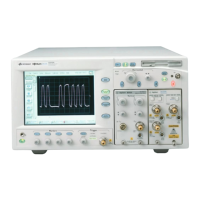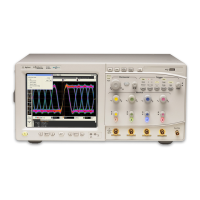Index-9
Index
SERial (SERial number), 4-13
serial poll
(SPOLL) in example, 1-16
disabling, 1-35
of the Status Byte Register, 1-16
serial prefix, reading, 3-5
Service Request
code and capability, 1-35
Service Request Enable
(*SRE), 3-12
Register (SRE), 1-16
Register Bits, 3-12
Register default, 1-34
setting
data rates, 9-2
Service Request Enable Register bits,
1-16
Standard Event Status Enable Regis-
ter bits, 1-19
time and date, 5-7
TRG bit, 1-16
voltage and time markers, 16-2
SETup, 5-7
setup
recall, 3-7
storing, 10-9
short form commands, 1-23
signal present
conditions, 9-2
status, 9-9
Signal Processing Commands, 20-2
LFEqualizer, 20-2, 20-3, 20-4, 20-5,
20-6
SIMage, 10-7
SINGle, 4-13
SKEW AUTO, 7-10
SKEW, in CALibrate command, 7-10
software version, reading,
3-5
SOURce, 14-4, 15-5, 17-10, 18-18, 18-42
and measurements, 18-4
SOURce?, 17-8
SPOLL example, 1-16
SPResent?, 9-9
*SRE (Service Request Enable), 3-12
SRE (Service Request Enable Regis-
ter), 1-16
SSAVer, 11-11
SSCReen, 6-4, 15-5, 17-10
SSCReen AREA, 6-5
SSCReen IMAGe, 6-6
SSUMmary, 15-7, 17-12
Standard Event Status Enable Register
(SESER), 1-19
bits, 3-3
default, 1-34
Standard Event Status Register (ESR),
1-18
bits, 3-4
Standard Status Data Structure Model,
1-11
STARt, 7-4–7-5, 17-12
STATe, 16-3, 17-6
status
registers, 3-2
Status Byte (*STB), 3-12
Status Byte Register, 1-11–1-16
and serial polling, 1-16
bits,
3-13
default, 1-34
status reporting, 1-11
bit definitions, 1-17
decision chart, 1-12
STATus, in CALibrate command, 7-10
STATus?, 7-5, 7-7
*STB (Status Byte), 3-12
STDDev?, 18-27
STIMulus, 21-10
STOP, 4-13
storage and retrieval, 10-2
STORe, 10-9
SETup, 4-13
WAVEform, 4-14
suffix
multipliers, 1-25
summary bits, 1-11
SWAVeform, 6-6, 15-8, 17-13
SWAVeform RESet, 6-7, 15-9, 17-13
syntax error, 1-46
System Commands, 5-2
DATE, 5-2
DSP, 5-2
ERRor?, 5-3
HEADer, 5-4
LONGform, 5-5
MODE, 5-6
SETup, 5-7
TIME, 5-7
system controller, 1-35
SYSTem SETup and *LRN,
3-6
T
talker
code and capability, 1-35
unaddressing, 1-35
TDR Commands, 19-2, 21-2, 22-2
TDRSkew, 8-7
TEDGe, in MEASure command, 18-43
temperature and calibration, 7-2
TER? (Trigger Event Register), 4-14
terminator, program message, 1-23
TEST, 15-9, 17-14
Test (*TST), 3-13
TIME, 5-7
time and date, setting, 5-2
time base
scale and number of points, 6-3
Time Base Commands, 23-2
time buckets, and POINts?, 25-7
time scale, operands and functions,
12-2
TIME?, 7-5, 7-7
timing measurements, displaying, 14-2
TITLe?, 17-14
TMAX, 18-44
TMIN, 18-45
TOPBase, and DEFine, ??–18-20
tracking, 11-5
transferring waveform data, 25-2
transmission mode, and FORMat, 25-6
*TRG (Trigger), 3-13
TRG (Trigger Event Register), 1-16
bit, 3-12–3-13
bit in the status byte, 1-16
Event Enable Register,
1-18
Trigger (*TRG), 3-13
status bit, 1-18
TRIGger Commands
DCDRatio, 24-3
DCDRatio AUTodetect, 24-3
Trigger Commands, 24-2
BWLimit, 24-3
HYSTeresis, 24-4
LEVel, 24-4
Trigger Event Register (TRG), 1-16
trigger status, 9-6
truncating numbers, 1-25
*TST (Test), 3-13
TVOLt?, 18-45
U
UEE (User Event Enable register), 4-14
UER, 1-19
UER? (User Event Register), 4-14
ULIMit, 15-9
unaddressing all listeners, 1-35
unavailable commands, Jitter mode,
1-43
UNITs, 8-7, 23-5
ATTenuation, 8-7
OFFSet, 8-8
uppercase letters, 1-23
URQ bit (User Request), 3-3
User Event Enable register, 4-14
User Event Register, 1-19, 4-14
User Request (URQ) status bit, 3-3

